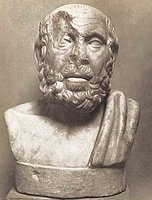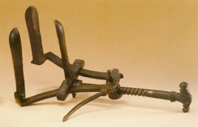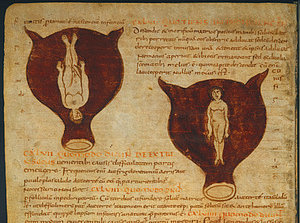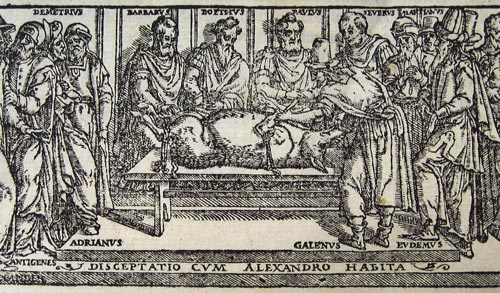
Ancient medical texts serve as sources for research into the history of science and culture, and as examples of Greek and Roman literature. Their prose style represents an important paradigm of specialist writing. The oldest fully extant works are those found in the collection of writings attributed to the physician Hippocrates of Cos (c. 460 - 370 BC). The majority of the texts, around 60 in all, date back to the 5th and 4th centuries BC. Written in the Ionian dialect, the texts demonstrate a wide variety of literary forms, deal with a wealth of subjects and exhibit a diversity of theoretical concepts.
The oldest items in the Hippocratic collection include records containing information on the symptoms and course of diseases (“Epidemics”, books I and III), a treatise on the meaning of signs for medical practice (“Prognosticon”) and two works dealing with bone surgery (“On Joints” and “On Fractures”), which testify to sound knowledge of the human skeletal structure. In the essay “On the Nature of Man”, the classical form of the doctrine of the four humours is expounded, and the humours - blood, phlegm, yellow and black bile - are coordinated to the primary qualities wet/warm, wet/cold, dry/warm, dry/cold, as well as to the four seasons, i.e. spring, winter, summer and fall, respectively. As a physiological conception, the theory that health consists in the equilibrium of the humours, and disease in the disturbance of the mixture retained its significance for medical thinking throughout antiquity and far beyond. The treatise “Airs, Waters and Places” deals with the influence of environmental factors on human health and illness.

A characteristic feature of Hippocratic medicine is the view that healthy and pathological processes in the human body are the result of natural conditions, and that diseases should be treated by rational means. The Hippocratic physician considers the patient an equal partner, whose dignity is to be protected in all respects. The successful treatment of a disease requires cooperation based on trust between the physician and patient. The ethical principles of Hippocratic medicine remain relevant even today.
Apart from a few texts belonging to the Hippocratic corpus which were not written until the Hellenistic period, the medical literature of this period has been lost almost entirely. That the literature of the Hellenistic period must have been extensive and substantial is clear from the frequent use made of it by later authors. Their reception of the Hellenistic legacy reveals that in the previous period, particularly in the specialized areas of anatomy, physiology, surgery and pharmacology, considerable progress had been made.

The establishment of individual medical disciplines is reflected in transmitted titles of lost works. Dating from the first half of the 3rd century BC, books entitled “Anatomical Studies”,“On Pulse” and “On the Eyes”, are attributed to Herophilus of Chalcedon, while Erasistratus of Ceos is credited with “On Fever”, “On Injuries” and “Hygienics”. In the first century BC, Crateuas wrote an illustrated herbal that has not survived, too. However, an illustrated commentary on the Hippocratic text “On Joints”, written by Apollonius of Citium, dating from the same period, and continuing the Hellenistic tradition of Hippocratic exegesis, has survived intact.
In the Alexandria of the 3rd century BC, physicians took advantage of the opportunity - without precedent in the ancient world - to conduct anatomical research on the basis of dissection of the human body. These procedures allowed errors to be corrected which had arisen due to the fact that findings based on dissection performed on animals had been applied uncritically to humans. The more precise knowledge of the location and structure of bodily organs in humans that resulted from the procedures had a positive effect on medical practice, especially on operative surgery.
Largely based on Hellenistic sources and comprising 8 books, “On Medicine” by Aulus Cornelius Celsus was probably composed during the reign of Emperor Tiberius (14-37). This work made the achievements of Greek scientific medicine available to Latin-speaking Romans for the first time. “On Medicine” is the only fully extant portion of an encyclopaedia which also featured treatises on agriculture, rhetoric, philosophy, military and law. Of the remaining treatises, only fragments dealing with agriculture and rhetoric have survived.
The fact that the aforementioned subject areas were dealt with on an equal footing as part of an encyclopaedic work constitutes an argument against their author’s having been a physician. The medical section is geared towards practical medical requirements, and possible treatment methods are distributed among the fields of dietetics, pharmacotherapy and surgery.
A few decades later, the physician Dioscorides, a native of Anazarbus in Asia Minor, composed the 5-volume “On Pharmacology”, the first systematic presentation of the subject available to us. Although the author has clearly made use of the relevant literature from the Hellenistic period, much of the work is nevertheless based on firsthand experience. The explanations consist of descriptions of drugs from the three kingdoms of nature, as well as their medicinal properties and applications. In the later tradition, the arrangement of material in the text was modified, and high-quality artistic illustrations were added.
The oldest surviving anatomical writing is a textbook entitled “On the Names of the Parts of the Human Body”, written by Rufus of Ephesus (c. 100). The main purpose of the work was to disseminate knowledge of anatomical nomenclature. However, the brief explanations also contain information on the location, shape and function of organs. Of particular interest is Rufus' essay “The Interrogation of Patients”, as it is to our knowledge the only ancient text that deals specifically with medical anamnesis.

One of the most important works of Rufus’ somewhat younger contemporary, Soranus of Ephesus (c. 120), has been passed down in the Greek original. The work, entitled “Gynaecology”, served up to the Middle Ages as the basis for gynaecological knowledge. The author also includes obstetrics, embryology, and infant care in the work. His textbook on acute and chronic diseases, however, has only survived in the Latin version of Caelius Aurelianus, dating from the beginning of the 5th century. Finally, a short treatise “On Bandages”, with accompanying illustrations, has survived in Greek.
In scope and content, the extant works of the physician Galen of Pergamum (129 to c. 215) constitute, together with the collection of Hippocratic writings, the most important contribution to ancient medical literature. In his work, independent medical research in antiquity reached its conclusion. The eclectic viewpoint he adopted allowed him to critically evaluate the achievements of the past and to integrate them into a comprehensive medical system. Consequently, in Galen’s works, valuable ideas contained in the lost writings of his predecessors are preserved, perhaps no longer in their authentic form, due to his high-handed treatment of the material available to him.

Galen occupied himself to varying degrees with nearly all medical specializations. He made independent contributions in many fields, but especially in anatomy, physiology, nosology, and pharmacology. His physiology and nosology were based on the Hippocratic theory of the four humours, which he further developed in connection with Aristotle’s theory of the four elements, coordinating the four humours of blood, phlegm, yellow and black bile to the four elements of air, water, fire and earth, which were held to be the basic elements of all existing things (the primary source for this is the treatise “On the Elements According to Hippocrates”). The connecting link consisted in the coordinating of the same combination of two primary qualities to one humour and one element. This expansion of the fourfold schema opened possibilities for the further development of the principles of Hippocratic medicine within the framework of Galen’s humoural-biological theory of disease.
The doctrine of the four primary qualities and the four elements also served as the theoretical basis of Galen’s pharmacology, which he outlined in a treatise entitled “On the Mixture and the Properties of Simple Drugs”. Because he considered drugs to be composed of the same element-based primary qualities as the human body, Galen was able to integrate pharmacology into a self-contained medical system. The property of a drug was derived, in his opinion, from the primary qualities prevailing in it. He classified these qualities with regard to the intensity of their properties into four degrees, subdividing each degree into three levels.
In accordance with his principle that only a unified approach to medical research combining empirical observation with theoretical understanding can succeed, Galen, in his treatise “On the Usefulness of the Parts of the Body”, elected a teleological approach to his subject matter, in that the goal of his presentation of anatomical structures was to prove their functional suitability. His knowledge of the anatomical structure of body parts was derived from dissections which, as is evident from such works as “On Anatomical Procedures”, he performed with a high degree of technical perfection on mammals. His depiction of the nervous system is based partly on vivisections, which aided him in demonstrating the presence of nervous system deficiencies through the interruption of nerve strands.

Hippocratic exegesis comprises a large portion of Galen’s writings. In his exegetic works, he carries on the tradition begun in the Hellenistic period of improving contemporary understanding of Hippocratic texts which were regarded as classic. By his own account, he commented only on those writings which he held to be authentic. These include, e.g. “Aphorisms”, books I-III and VI of “Epidemics”, the treatise “On the Nature of Man”, and the works on bone surgery.
In late antiquity and the early Byzantine period, the medical authors of Greek-speaking areas were primarily concerned with summarizing knowledge gained in the past in a structured manner in order to preserve it for practical medical use. The resultant handbooks are also valuable from a scientific perspective due to their use of excerpts of previous texts, the originals of which are no longer extant.
The oldest of these works is the 70-book “Collection of Medical Texts” composed by Oribasius, who worked as imperial physician at the court in Constantinople in the middle of the 4th century. In the 6th century, Aetius of Amida wrote a similar compilation in 16 books, which included magical practices among the therapeutic measures described. The list of medical handbooks written for practical purposes also includes a 12-book work in which Alexander of Tralles, working at around the same time, summarizes the knowledge gained in his many years of activity as a physician. His occasional criticism of the authorities of previous epochs provides evidence of independent judgement on his part. The 7-volume handbook written by Paul of Aegina was understood by its author to be a presentation of practical medicine based on the medical literature of the past. He deals with all illnesses from the point of view of diagnosis, etiology and therapy. Paul explicitly testifies to his literary dependence on Oribasius.
The fully or partially extant early Byzantine commentaries on certain works by Hippocrates and Galen constitute a unique sort of literary evidence, in that they consist of transcripts of oral discourses. They document teaching in the medical training centres of the Byzantine age. Among the academic instructors active in 6th and 7th century Alexandria were Stephanus of Athens and John of Alexandria. Explanations of the Hippocratic writings “Prognosticon” and “Aphorisms” and the first book of Galen’s “On Therapeutic Methods, Dedicated to Glaucon” are based on Stephanus’ lectures, while fragments of the commentary to book VI of the Hippocratic “Epidemics” and a large fragment of the beginning of an interpretation of the Hippocratic text “On the Nature of Children” are based on the lectures of John.
In areas where Latin was spoken, medical literature in late antiquity was more practically oriented than in the eastern part of the empire. These areas also exhibited a tendency to introduce superstitious practices and cures from the so-called Dreckapotheke alongside scientific medical procedures.
| Bei varuli, d.h. bei Gerstenkörnern an den Augen, bereitet man folgendes Heilmittel: Man zieht die Ringe von den Fingern ab, hält sie mit drei Fingern der linken Hand um das Auge herum, spuckt dreimal aus und sagt dreimal: RICA RICA SORO. Wenn sich am rechten Auge ein Gerstenkorn gebildet hat, hält man mit der linken Hand mit drei Fingern, während man unter freiem Himmel nach Osten sieht, das Gerstenkorn und sagt: Die Mauleselin gebiert nicht, und der Stein trägt keine Wolle, Wenn man diese Worte gesagt hat, berührt man mit denselben drei Fingern die Erde, spuckt aus und tut das dreimal. Magic spell from Marcellus, “On Remedies”, 8,190f.: CML V, p. 161 |
The collection of prescriptions entitled “On Remedies” which Marcellus of Bordeaux (c. 400), a high-ranking government official, composed as a layman for other laymen is based primarily on older sources. Due to its author’s origins, traces of Celtic language have been preserved in the collection. Dating from around the same period, a 3-book treatise by Theodorus Priscianus entitled “Easily Obtained Remedies” describes methods for treating external, internal and gynaecological illnesses. Cassius Felix followed Greek models in compiling his mid-fifth-century work “On Medicine”. The author’s intention was that the work should contain everything that had proven appropriate for the treatment of the human body.
Text: J. Kollesch, D. Nickel; Translation: J. Crone
cf. Brochure of Corpus Medicorum Graecorum / Latinorum, Berlin 2004
(c) BBAW